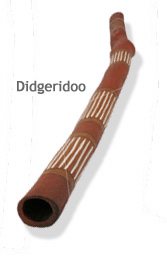
Here’s an odd item you don’t normally see in health news: Swiss doctors had patients learn to play a bizarre wind instrument called a didgeridoo, and it seemed to help reduce their snoring. But be forewarned before you think of trying it yourself -- the bellowing sounds of the didgeridoo may be more offensive than the snoring itself!
 Never heard of a didgeridoo? Northern Australia’s Aborigines have played this instrument for thousands of years as part of ceremonial life, believing it has spiritual and healing powers. The ancient instrument is made from eucalyptus logs hollowed by termites. It’s played by vibrating the lips to produce a continuous, deep drone that goes something like: Never heard of a didgeridoo? Northern Australia’s Aborigines have played this instrument for thousands of years as part of ceremonial life, believing it has spiritual and healing powers. The ancient instrument is made from eucalyptus logs hollowed by termites. It’s played by vibrating the lips to produce a continuous, deep drone that goes something like: Pththtwwwaaaggghhhhaaaggghhhaaaggghhhaaaggghhhaaaggghhh. This haunting, powerful sound emanates while you perform a technique called circular breathing. You breathe in through your nose while pushing air out with your tongue and cheeks. Some say the drone relaxes you, connecting you spiritually with the Earth. (Don’t play at night, or your spouse might make a spiritual connection between your head and a frying pan.) The Swiss researchers taught 25 patients circular breathing while playing PVC plastic didgeridoos. The patients trained for 4 months, playing about half an hour a day, 6 days a week. By study’s end, the researchers said the exercise had had strengthened the muscles in the patients’ upper airways. As a result they had better sleep apnea scores… and their partners were reporting fewer sleep disturbances. Apnea, teach your children it's not a dirty word Consider the muscles in your upper airway. During sleep, they relax. With obstructive sleep apnea, they relax too much, briefly blocking your airways. This interrupts your breathing. These pauses last long enough for you to miss a breath or two. Then your brain figures out you are due for a breath, and the result is a sudden GASP. This happens throughout the night, and you are left with poor, fragmented sleep.  Apnea episodes have been described several ways: Sometimes you awake and bolt upright in bed, gasping for breath, overwhelmed by the sense that you can’t breathe. Sometimes you wake up with a lump in your throat, afraid to swallow, as if you are choking on loose change. But often, you aren’t aware of the episodes at all. Apnea episodes have been described several ways: Sometimes you awake and bolt upright in bed, gasping for breath, overwhelmed by the sense that you can’t breathe. Sometimes you wake up with a lump in your throat, afraid to swallow, as if you are choking on loose change. But often, you aren’t aware of the episodes at all.
When this happens night after night, you wind up at risk for heart problems, memory problems…and perhaps even marital problems. The most successful treatment for sleep apnea is called continuous positive airway pressure (CPAP). This machine continuously blows air through a hose hooked to a mask that you wear while sleeping. Wearing one, you may feel a bit uncomfortable – perhaps it’s not a surprise when you hear that people who receive this treatment tend not to stick with it. This won't hurt...much There are medications available for the side effects, but they don’t treat the condition itself. Another option is surgery. You can have them remove tissue at the back of your throat or inside your nose, take out your tonsils or adenoids, trim down parts of the soft palate of your mouth. Yet another option is to wear a dental appliance, a small plastic mouth guard that keeps the soft tissues at the back of the mouth open. None of these options may sound particularly fun, but if your health is at stake, you do what you have to do. I’m betting the Aborigines don’t have these issues. If it were me seeing the doctor today… I’d ask him to forget the other methods. I’ll take a prescription for a didgeridoo, please.  | David R. Eltz is managing editor of Synergy and editorial director for A.D.A.M., Inc. and has long been acquainted with sleep loss. David can be reached at featuredstories@adamcorp.com. |
|